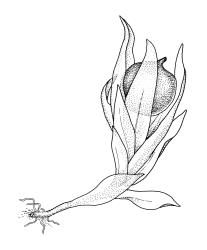Plants very small, gregarious, dark green. Stems 0.5–1.5 mm, red-brown, unbranched, cross-section anatomy not clearly seen, beset near base with smooth, red-brown rhizoids. Leaves incurved around the capsule when dry, spreading when moist, oblong-lanceolate, moderately concave, those of coma c. 1.5 × 0.4–0.5 mm, smaller below (to c. 2 mm in Australian material), acute, margins plane, entire or weakly and bluntly toothed near apex; upper laminal cells oblong-hexagonal, thin-walled, mostly 39–60 × 18–27 µm (some more irregular), becoming larger and more oblong near leaf base, and more compact near apex; marginal cells not differentiated; alar cells slightly inflated but not distinct; costa ½ to ¾ the leaf length, red-brown, mostly unbranched but sometimes weakly bifurcate, in cross-section atypical of the family and lacking stereids. Axillary hairs not seen.
Sexuality uncertain. Perichaetia terminal. Perigonia not differentiated. Setae dark, c. 100 µm (vaginula c. 300 µm long); capsule erect, globose, inoperculate, disintegrating irregularly, 400–500 µm diam. (excluding rostrum), stoutly rostrate, lacking an obvious air space beneath the exothecium, dark red at maturity due to the colour of the enclosed spores, with columella absent at maturity; rostrum straight or oblique, longer than wide, c. 150–200 × c. 50 µm; exothecial cells very thin-walled, oblong-hexagonal, hyaline, at mid urn mostly c. 60 × 30 µm; stomata few and obscure, single-celled, restricted to base of the capsule. Calyptra minute, neither clearly mitrate nor cucullate, c. 0.4 mm, lobed at base covering only the rostrum. Spores spherical to slightly tetragonal, red-brown, uniformly spinose, 30–39 µm diam., a few with weak trilete scars.
Much confusion surrounds the relationships and the consequent nomenclature of N.Z. material treated here as Physcomitridium readeri. Much of this confusion is due to the near impossibility of distinguishing Physcomitridium from Physcomitrella Bruch & Schimp. without using genetic markers.
The sole species of Physcomitridium was originally described as Ephemerella readeri Müll.Hal. However, the type species of Ephemerella Müll.Hal. [Syn. Musc. Frond. 1: 34, 1848] is the European Ephemerella pachycarpa (Schwägr.) Müll.Hal., which is conspecific with Ephemerum recurvifolium (Dicks.) Boulay (Goffinet & Buck 2011). Thus, the generic name Ephemerella is nomenclaturally synonymous with Ephemerum.
Since its description, the minute Physcomitridium readeri has been shifted between the genera Physcomitridium (where it was treated by Sainsbury 1955) and Physcomitrella (where it was treated by Stone & Scott 1973; Tan 1979; and Fife & Seppelt 2001). Physcomitridium readeri has also been recognised as both a species (Stone & Scott 1973, as Physcomitrella readeri) and as a subspecies (Tan 1979, as Physcomitrella patens subsp. readeri). Fife & Seppelt (2001) accepted the last placement and ranking in their discussion of Australian representatives of the Funariaceae.
Regionally the confusion surrounding Physcomitridium and Physcomitrella was partly caused by Sainsbury’s (1955, p. 248) description of what he termed Physcomitridium readeri. Sainsbury’s description of alleged P. readeri was written using Bryobeckettia bartlettii from Wairoa and Kelso, collected by E.A. Hodgson and W. Martin, respectively. The Kelso material, in addition to representative B. bartlettii, also includes numerous inter-generic hybrid [Bryobartlettia bartlettii ♀ × Physcomitrium pyriforme ♂] sporophytes, which generated further confusion. In short, the plants named and described by Sainsbury as Physcomitridium readeri (Müll.Hal.) Roth belong to neither that species nor that genus.
An enormous literature has grown up around the northern hemisphere Physcomitrella patens (Hedw.) Bruch & Schimp. because of its widespread use in the study of gene expression (e.g., Rensing et al. 2008). Consequently, the morphologically similar Physcomitridium readeri has also become the object of molecular investigations (McDaniel et al. 2010; Hooper et al. 2010). Liu et al. (2012) used 10 gene loci from nuclear, chloroplast, and mitochondrial genomes to present an impressive outline of relationships in the Funariaceae, including members of Physcomitrella s.s. and Physcomitridium. The collective results of these three molecular studies demonstrate that Physcomitrella s.l. is polyphyletic and argue persuasively for the recognition of Physcomitridium as a distinct genus. The remarkable similarity of their sporophytes is thus a result of convergent evolution or homoplasy.
N.Z. material of the taxon "readeri" is best treated in Physcomitridium rather than in Physcomitrella, where it has often been placed.
| Category | Number |
|---|---|
| Indigenous (Non-endemic) | 1 |
| Total | 1 |




